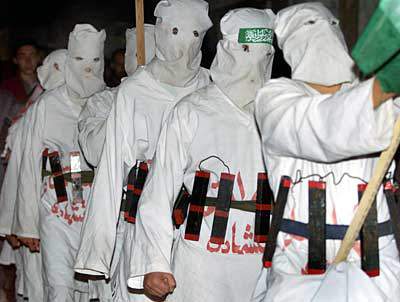Yearning for suicide, glory or both?
 The topic of this Boston Globe magazine piece could not be more explosive -- literally. It's about suicide bombers and the controversial issue of why they do what they do. But let's begin at the very beginning -- before the article even gets started.
The topic of this Boston Globe magazine piece could not be more explosive -- literally. It's about suicide bombers and the controversial issue of why they do what they do. But let's begin at the very beginning -- before the article even gets started.
As working journalists know, reporters very, very rarely have much input into the headlines that go with their stories. Readers, however, rarely seem to realize this and often blame the scribes for this crucial part of the package that contains their words. That's precisely what I was tempted to do when I read the headline on this report by veteran feature writer Paul Kix.
That headline?
The truth about suicide bombers
Are they religious fanatics? Deluded ideologues? New research suggests something more mundane: They just want to commit suicide.
Now, when you combine that headline with the powerful opening anecdote, the impression is that this is going to be a rather one-sized advocacy piece for those who have gathered this "new research." The top of the story is quite dramatic. Still, this is just an anecdote.
Qari Sami did something strange the day he killed himself. The university student from Kabul had long since grown a bushy, Taliban-style beard and favored the baggy tunics and trousers of the terrorists he idolized. He had even talked of waging jihad. But on the day in 2005 that he strapped the bomb to his chest and walked into the crowded Kabul Internet cafe, Sami kept walking -- between the rows of tables, beyond the crowd, along the back wall, until he was in the bathroom, with the door closed. And that is where, alone, he set off his bomb.
The blast killed a customer and a United Nations worker, and injured five more. But the carnage could have been far worse. Brian Williams, an associate professor of Islamic studies at the University of Massachusetts Dartmouth, was in Afghanistan at the time. One day after the attack, he stood before the cafe's hollowed-out wreckage and wondered why any suicide bomber would do what Sami had done: deliberately walk away from the target before setting off the explosives. "[Sami] was the one that got me thinking about the state of mind of these guys," Williams said.
Eventually a fuller portrait emerged. Sami was a young man who kept to himself, a brooder. He was upset by the US forces' ouster of the Taliban in the months following 9/11 -- but mostly Sami was just upset. He took antidepressants daily. One of Sami's few friends told the media he was "depressed."
Today Williams thinks that Sami never really cared for martyrdom; more likely, he was suicidal.
This leads straight to the thesis statement that begins by summarizing the traditional interpretation of the actions and motives of suicide bombers. Yes, this does include an oh-so-typical abuse -- as defined by Associated Press style -- of the word "fundamentalist." The bombers are said to hate the Western world because its cultural norms "contradict the fundamentalist interpretations that animate the bombers' worldview."
Sigh. This has become almost normal these days. So let's move on. Readers immediately hit the crucial new wrinkle, the one screamed in the headline.
... Williams is among a small cadre of scholars from across the world pushing the rather contentious idea that some suicide bombers may in fact be suicidal. At the forefront is the University of Alabama's Adam Lankford, who recently published an analysis of suicide terrorism in the journal Aggression and Violent Behavior. Lankford cites Israeli scholars who interviewed would-be Palestinian suicide bombers. These scholars found that 40 percent of the terrorists showed suicidal tendencies; 13 percent had made previous suicide attempts, unrelated to terrorism. Lankford finds Palestinian and Chechen terrorists who are financially insolvent, recently divorced, or in debilitating health in the months prior to their attacks. A 9/11 hijacker, in his final note to his wife, describing how ashamed he is to have never lived up to her expectations. Terrorist recruiters admitting they look for the "sad guys" for martyrdom.
For Lankford and like-minded thinkers, changing the perception of the suicide bomber changes the focus of any mission that roots out terrorism. If the suicide bomber can be viewed as something more than a brainwashed, religiously fervent automaton, anticipating a paradise of virgins in the clouds, then that suicide bomber can be seen as a nuanced person, encouraging a greater curiosity about the terrorist, Lankford thinks. The more the terrorist is understood, the less damage the terrorist can cause.
It's a fascinating idea and, as the article clearly states, one that remains new and quite controversial. For starters, religious doctrine is involved. Where does "suicide" -- forbidden by the Koran -- end and the quest for "martyrdom" begin as a believer seeks to give his or her life to earn the "pleasure of Allah"?
 In effect, Kix is attempting to cover the very complex debates about why so many Muslims seek martyrdom. The headline suggests that this will be a one-sided article. It isn't.
In effect, Kix is attempting to cover the very complex debates about why so many Muslims seek martyrdom. The headline suggests that this will be a one-sided article. It isn't.
I am sure -- trust me, I am sure -- that many experts on both sides of the debate could find holes in the article. Still, I think that it's important to note that Kix is covering a debate and it appears that he has found top quality voices of authority on both sides.
A key question quickly emerges: Can Western researchers truly understand the motives of most suicide bombers if what is taking place is essentially a religious rite, an act of faith? And for others, the debate is essentially a question of mathematics.
One study in the academic literature directly refutes Lankford's claim, and that's the University of Nottingham's Ellen Townsend's "Suicide Terrorists: Are They Suicidal?" published in the journal Suicide and Life Threatening Behavior in 2007. (The answer is a resounding "no.")
Townsend's paper was an analysis of empirical research on suicide terrorism -- the scholars who'd talked with the people who knew the attackers. In Lankford's own paper a few years after Townsend's, he attacked her methodology: relying as she did on the accounts of a martyr's family members and friends, who, Lankford wrote, "may lie to protect the 'heroic' reputations of their loved ones."
When reached by phone, Townsend had a wry chuckle for Lankford's "strident" criticism of her work. Yes, in the hierarchy of empirical research, the sort of interviews on which her paper is based have weaknesses: A scholar can't observe everything, can't control for all biases. "But that's still stronger evidence than the anecdotes in Lankford's paper," Townsend said.
As Robert Pape of the University of Chicago also notes:
... "(We) have a handful of incidents of what looks like suicide and we have over 2,500 suicide attackers. We have literally hundreds and hundreds of stories where religion is a factor -- and revenge, too. ... To put his idea forward, [Lankford] would need to have a 100 or more stories or anecdotes to even get in the game."
He's working on that. Lankford's forthcoming study, to be published early next year, is "far more robust" than his first: a list of more than 75 suicide terrorists and why they were likely suicidal.
And so forth. It's sobering, at times quite depressing, material that is literally haunted by religion and doctrinal debates. The story is real and so is the debate. That's called "journalism."
This is one story that deserved a much more nuanced headline.